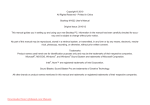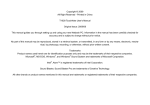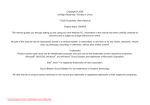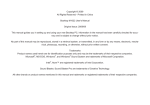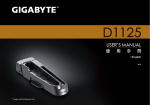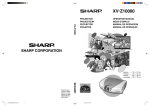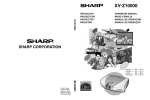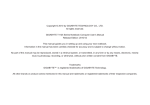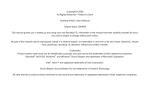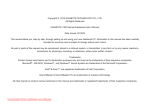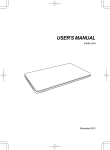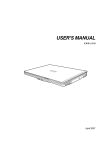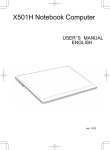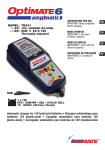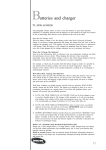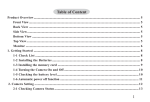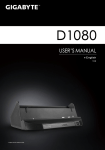Download Printed in China Q1088 Netbook User`s Manual Original
Transcript
Copyright © 2009 All Right Reserved - Printed in China Q1088 Netbook User's Manual Original Issue: 2009/07 This manual guides you in setting up and using your new Netbook PC. Information in the manual has been carefully checked for accuracy and is subject to change without notice. No part of this manual may be reproduced, stored in a retrieval system, or transmitted, in any form or by any means, electronic, mechanical, photocopy, recording, or otherwise, without prior written consent. Trademarks Product names used herein are for identification purposes only and may be the trademarks of their respective companies. Microsoft®, MS-DOS, Windows®, and Windows® Sound System are trademarks of Microsoft Corporation. Intel®, Atom™ is registered trademarks of Intel Corporation. Sound Blaster, Sound Blaster Pro are trademarks of Creative Technology. All other brands or product names mentioned in this manual are trademarks or registered trademarks of their respective companies. Safety Instructions Use the following safety guidelines to help protect yourself and your Netbook. English I When Using Your Q1088 Netbook Computer CAUTION: Do not operate your portable computer for an extended period of time with the base resting directly on your body. With extended operation, heat can build up in the base. Allowing sustained contact with the skin can cause discomfort or a burn. •Do not attempt to service the Netbook yourself. Always follow installation instructions closely. •Do not carry a battery in your pocket, purse, or other container where metal objects (such as car keys) could short-circuit the battery terminals. The resulting excessive current flow can generate extremely high temperature and may cause burns to your skin. •Be sure that nothing rests on your AC adapter's power cable and that the cable is not located where it can be tripped over or stepped on. •While you are using the computer or charging the battery, place the AC adapter in a ventilated area, like on a desktop or on the floor. Do not cover the AC adapter with papers or other items that may prevent ventilation. Also, do not use the AC adapter while it is inside a carrying case. •Do not insert objects into the air vent of your Netbook computer. Doing so can cause short-circuiting and may result in fire or electrical shock. •Use only the AC adapter and batteries that are supplied by your Netbook manufacturer. Using other types of battery or AC adapter may heighten the risk of fire or explosion. •Incorrectly placed batteries may result in an explosion. •Replace only with the same or compatible battery recommended by the manufacturer. •Please discard used batteries according to the manufacturer's instructions. •Before you connect your Netbook to a power source, ensure that the voltage rating of the AC adapter matches that of the available power source. -115 V/60 Hz in most of North and South America and some Far Eastern countries such as South Korea. -100 V/50 Hz in eastern Japan and 100 V/60Hz in western Japan. -230 V/50 Hz in most of Europe, the Middle East, and the Far East. •If you use an extension cord with your AC adapter, ensure that the total ampere rating of all devices plugged into the extension cord does not exceed its total capacity. •When removing battery from your Netbook, first turn off the system, disconnect the AC adapter from the electrical outlet, and then remove the battery. •To avoid risk of an electrical shock, do not connect or disconnect any cables, or perform maintenance or reconfiguration of this product during a thunderstorm. •Do not throw batteries into fire, doing so may cause explosion. Check with local authorities first for battery disposal instructions. •When setting up your Netbook for work, place it on a level surface. Q1088 Netbook USER’S MANUAL NOTICE: When taking your Netbook from a colder to a warmer environment or vice versa, allow your Netbook enough time to adapt to the new environment before turning on power. •When unplugging the power cord, please make sure that you pull on its connector or on its strain relief loop, and not on the power cord itself. As you pull out the connector, please ensure that it is pulled out evenly in order not to bend its connecting pins. Also, before you connect the power cord, make sure that both connectors are correctly oriented and aligned. •Before you clean your Netbook, turn it off first, unplug it from its power source, and remove the battery. •Handle interior components with care. When removing a component, please hold it by the edge and not on the connecting pins (such as the memory module). When using your telephone equipments, safety instructions should always be followed in order to prevent fire, electrical shock or injuries, these instructions include: •Do not use this product near water, for example, near a bathtub, washing basins, kitchen/laundry sinks, wet basements or swimming pools. •Avoid using cordless phones during an electrical storm as lightening may cause electrical shocks. •Do not use the telephone to report a gas leak within the leakage area. WARNING: Void of Warranty * If the battery is not properly handled, there may be a risk of explosion; make sure you are using the same or compatible battery. * Please discard used batteries according to the instructions given by the manufacturer. * Please be aware that use of cracked, severely scratched or poor quality discs may damage the optical drive and corrupt data in the disc. Such discs may break while drive operates in highspeed, in this case, your product warranty may be voided. English •When traveling, do not check your Netbook as baggage. You can put your Netbook through an X-ray security machine, but never put your Netbook through a metal detector. If you have your Netbook checked by hand, be sure to have a charged battery ready in case you are asked to turn on your Netbook. •When traveling with the hard drive removed from your Netbook, wrap the drive in an insulated material, such as cloth or paper. If you have the drive checked by hand, you may be asked to install the drive into your Netbook. Your can have the hard drive checked through an X-ray machine, but never put the drive through a metal detector. •When traveling, do not place your Netbook in the overhead storage compartment where it could shift around. Do not drop your Netbook or subject it to other mechanical shocks. •Protect your Netbook, battery, and hard drive from environmental hazards such as dirt, dust, food, liquids, extreme temperature, and direct exposure to sunlight. •When you move your Netbook in environments where there is a substantial difference of temperature or humidity level, condensation may form on or within your Netbook. To avoid damaging your Netbook, please allow sufficient time for the moisture to evaporate before continue using. II Regulatory Notices English III Federal Communications Commission Notice RF exposure This equipment has been tested and found to comply with the limits for a Class B digital service, pursuant to Part 15 of the FCC rules. These limits are designed to provide reasonable protection against harmful interference in a residential installation. This equipment must be installed and operated in accordance with provided instructions and must not be co-located or operating in conjunction with any other antenna or transmitter. End-users and installers must be provide with antenna installation instructions and transmitter operating conditions for satisfying RF exposure compliance. Any changes or modifications made to this equipment may void the user’s authority to operate this equipment. This equipment generates, uses, and can radiate radio frequency energy. If not installed and used in accordance with the instructions, may cause harmful interference to radio communications. However, there is no guarantee that interference will not occur in a particular installation. If this equipment does cause harmful interference to radio or television reception, which can be determined by turning the equipment off and on, the user is encouraged to try to correct the interference by one or more of the following measures: ●Reorient or relocate the receiving antenna. ●Increase the separation between the equipment and receiver. ●Connect the equipment into an outlet on a circuit different from that to which the receiver is connected. ●Consult the dealer or an experienced radio/TV technician for help. ●All external cables connecting to this basic unit must be shielded. For cables connecting to PCMCIA cards, see the option manual or installation instructions. SAR Value:0.323 W/Kg Q1088 Netbook USER’S MANUAL CE Notice (European Union) • EN 55022 — “Limitations and Methods of Measurement for the Radio Interferences of Information Technology Equipment.” • EN 55024 — “Information technology equipment - Immunity characteristics - Limits and methods of measurement.” • EN 61000-3-2 — “Electromagnetic compatibility (EMC) - Chapter 3: Limits - Section 2: Limits on the harmonic current emissions (Equipment input current up to and including 16 A per phase).” • EN 61000-3-3 — “Electromagnetic compatibility (EMC) - Chapter 3: Limits - Section 3: Limits on the voltage fluctuations and flicker in low-voltage power supply systems for equipment with rate current up to and including 16 A.” • EN 60950 — “Safety of Information Technology Equipment.” NOTE: EN 55022 emissions requirements provide for two classifications • Class A governs commercial use • Class B is governs residential use For CB: • Only use batteries designed for this computer. The wrong battery type may explode, leak or damage the computer • Do not remove any batteries from the computer while it is pow- Battery Disposal & Caution The product that you have purchased contains a rechargeable battery. The battery is recyclable. At the end of its useful life, under various state and local laws. It may be illegal to dispose of this battery into the municipal waste stream. Check with your local solid waste officials for details in your area for recycling options or proper disposal. English This symbol indicates this Q1088 Netbook computer complies with the EMC Directive and the European Union’s Low Voltage Directive. This symbol also indicates that Q1088 meets the following technical standards: ered on • Don not continue to use a battery that has been dropped, or that appears damaged (e.g. bent or twisted) in any way. Even if the computer continues to work with a damaged battery in place, it may cause circuit damage, which may possibly result in fire. • Recharge the batteries using the Netbook’s system. Incorrect recharging may make the battery explode. • Do not try to repair a battery pack. Refer any battery pack repair or replacement to your service representative or qualified service personnel. • Keep children away from, and promptly dispose of a damaged battery. Always dispose of batteries carefully. Batteries may explode or leak if exposed to fire, or improperly handled or discarded. • Keep the battery away from metal appliances. • Affix tape to the battery contacts before disposing of the battery. • Do not touch the battery contacts with your hands or metal objects. IV Danger of explosion if battery is incorrectly replaced. Replace only with the same or equivalent type recommended by the manufacturer. Discard used battery according to the manufacturer’s instructions. English V BSMI Notice (Taiwan Only) Most Netbook computers are classified by the Bureau of Standards, Meteorology and Inspection (BSMI) as Class B information technology equipment (ITE). The symbol above must be attached to the product indicating compliance with the BSMI standard. Q1088 Netbook USER’S MANUAL English VI English Preface VII Congratulations on your purchase of a Netbook computer! Your new Netbook features the most innovative features in portable computing technology. It combines state-of-the-art ergonomics with sophisticated architecture, providing you with a personal computer that is compact, powerful, and easy to use. Designed for a wide range of general, business, and personal productivity applications, this Netbook is an ideal choice for use in the office, at home, and on the road. This Manual contains all the information you need to set up and use your Netbook computer. It describes all of its features in a thorough yet easy-to-read manner. Q1088 Netbook USER’S MANUAL Chapter 3 TROUBLESHOOTING 3.1 Identifying the Problem........................................................... 16 Safety Instructions..............................................................................I Regulatory Notices...........................................................................III Preface............................................................................................VII Chapter 4 Recovery Update How to restore your Booktop to factory defaults............................. 18 Chapter 1 BEFORE YOU START 1.1 Make sure you have everything................................................ 4 1.2 Familiarize yourself with the computer..................................... 4 Opening the display panel........................................................ 4 Front overview..........................................................................5 Left side overview..................................................................... 6 Right side overview.................................................................. 6 Back overview..........................................................................7 Bottom overview....................................................................... 8 Chapter 2 GETTING STARTED 2.1 Power Sources....................................................................... 10 Connecting the power adapters............................................. 10 Preserving battery life............................................................. 10 Recharging the battery........................................................... 10 2.2 Starting your Netbook............................................................. 11 Power on................................................................................11 Status Indicators.....................................................................12 Using Function Keys.............................................................. 13 Using the TouchPad............................................................... 13 English Contents VIII Q1088 Netbook USER’S MANUAL This chapter will show you how to operate your Q1088 Netbook computer, including turning the computer on/off, using touch-pad, keyboard, battery, and so on. If you are new to computers and to the operating system, this chapter will guide you through some of the new exciting features. English Chapter 1 BEFORE YOU START 1 TAKING CARE OF YOUR Netbook PC English To prevent possible overheating of the computer's processor, make sure you don't block the openings provided for ventilation. DO NOT place or drop objects on the computer and DO NOT apply heavy pressure on it. DO NOT press or touch the display panel. DO NOT subject the computer to magnetic fields. DO NOT place on uneven or unstable work surfaces. DO NOT expose to direct sunlight. DO NOT use your Netbook computer under harsh conditions. DO NOT use or store in extreme temperatures. 2 Q1088 Netbook USER’S MANUAL DO NOT expose to dust and/or corrosive chemicals. English Avoid sudden changes in temperature or humidity by keeping it away fromA/C and heating vents. 3 DO NOT expose the computer to rain or moisture. DO NOT place near fire or other sources of heat. DO NOT tamper with the batteries. Keep them away from children. DO NOT slam your Netbook shut and never pick up or hold your Netbook by the display. DO NOT spray water or any other cleaning fluids directly on the display. If you are traveling with your computer, remember to carry it as hand luggage. Do not check it in as baggage. English 4 1.1 Make sure you have everything 1.2 Familiarize yourself with the computer When you receive your Netbook PC, unpack it carefully, and check to make sure you have all the items listed below. For a preconfigured model you should have the following: yy Netbook Computer yy Lithium-Ion battery yy AC adapter with power cord OPENING THE DISPLAY PANEL Depending upon the configuration of your Netbook, you may also need the following items: yy DVD / CD-RW Combo Application CD yy Dual DVD+/-RW Application CD yy Super Multi DVD RW Application CD Once you have checked and confirmed that your Netbook system is complete, read through the following pages to learn about all of your Netbook components. NOTE Depending on the model you purchased, the actual appearance of your Netbook may vary from that shown in this manual. To open the display panel, simply lift the lid up. When closing it, be sure not to slam it shut. Q1088 Netbook USER’S MANUAL FRONT OVERVIEW No. Item The built-in 0.3 megapixel camera allows you to snap a photo or create a video chat or video conference with just a click. 2 Microphone The built-in microphone allows for stereo reception and transmission of voice and/ or other audio data onto your Netbook. 3 Status Indicator Lights The Status indicator lights correspond to specific operating modes. These modes are: Power on/ Suspend status, battery/ AC adapter status, hard drive activity (HDD), Num Lock, Caps Lock, and 3G/ Wireless LAN activity. 4 TouchPad Pointing Device The TouchPad pointing device is a mouse-like cursor control with two buttons and a touch sensitive movement pad. 5 3G/Wireless LAN The 3G/Wireless LAN switch allows Switch you to switch your wireless connection between 3G and Wireless LAN. Switch to the left for 3G connection, and switch to the right to turn on Wireless LAN. 6 Keyboard The keyboard comes with 84 keys, including dedicated Windows® keys. 7 Suspend/Power On Button This button turns your Netbook on and off or puts it to sleep. (See Suspend/Power On Button in the Power On section for more information.) 8 Display Panel The display panel is a color LCD panel with back lighting for the display of text and graphics. 8 3 7 6 4 3 5 English Camera 1 2 Function 1 5 LEFT SIDE OVERVIEW RIGHT SIDE OVERVIEW The following is a brief description of the left side of the Netbook. 1 2 3 4 1 2 3 4 5 English 6 No. 1 Item Power Adapter Port Function The power adapter port allows you to plug in the AC adapter to power your Netbook and charge the internal Lithium-Ion battery. 2 External Monitor The external monitor port allows you to Port connect an external monitor. 3 LAN (RJ-45) Port The LAN port is designed to support a 10/100 Base-TX standard RJ-45 plug. 4 USB Port The USB port allows you to connect a Universal Serial Bus device. It supports v2.0 of the USB standard, which allows data exchange rates as high as 480 Mb/s. No. Item Function 1 Microphone Jack The microphone jack allows you to connect an external mono microphone. 2 Headphone Jack The headphone jack allows you to connect headphones or external speakers and amplifiers. 3 USB Ports The USB ports allow you to connect Universal Serial Bus devices. They support v2.0 of the USB standard, which allows data exchange rates as high as 480 Mb/s. 4 The memory card reader offers the fastest and most convenient method to transfer picMemory Card tures, music and data between your Netbook Reader and flash compatible devices such as digital cameras, MP3 players, mobile phones, and PDAs. Q1088 Netbook USER’S MANUAL 5 Kensington Lock Slot The Kensington lock slot allows you to secure your Netbook to an immovable object with an optional security cable. BACK OVERVIEW The following is an overview of the back of the Netbook. English 7 BOTTOM OVERVIEW The following is an overview of the bottom of the Netbook. English 1 2 No. 3 Compartment Cover 2 Lithium-Ion Battery Bay The battery bay contains the internal Lithium-Ion battery. It can be opened for the removal of the battery when stored over a long period of time or for swapping a discharged battery with a charged Lithium-Ion battery. 3 Rating Label The label shows the model number and other information about your Netbook. 4 Fan Outlet This is an open port for the fan to dissipate heat from the computer's internal components. Do not block or place the computer in such a position that you inadvertently allow the outlet to become blocked. 5 Stereo Speakers The built-in dual speakers allow for stereo sound. 4 5 Function The 3G module compartment contains the 3G module (Not available in all configurations). 1 8 Item Q1088 Netbook USER’S MANUAL English Chapter 2 GETTING STARTED 9 2.1 Power Sources Your computer has two types of power source: a Lithium-Ion battery or an AC adapter. English 10 CONNECTING THE POWER ADAPTERS The AC adapter provides power for operating your notebook PC and charging the battery. Connecting the AC Adapter 1. Plug the DC output cable into the DC power jack of your notebook PC. 2. Plug the AC adapter into an AC electrical outlet. Switching from AC Adapter Power to Battery Power 1. Be sure that you have at least one charged battery installed. 2. Remove the AC adapter. Your notebook will automatically switch from DC power to battery power. NOTE The Lithium-Ion battery is not charged upon purchase. Initially, you will need to connect the AC adapter to use your notebook PC. CAUTION To protect your notebook from damage, use only LithiumIon batteries that meet the specification. Improper use of batteries may lead to explosion and bodily harm. CAUTION Do not dispose of batteries with household waste. Contact your local recycling center or waste disposal operator to properly dispose of batteries according to the local laws and regulations of your region. PRESERVING BATTERY LIFE yy Fully discharge and recharge the battery every 30 days to prolong battery life. yy If the battery is not used for a month or longer, remove and store the battery in a cool, dry place. Fully recharge the battery before using again. RECHARGING THE BATTERY The Lithium-Ion battery is recharged internally using the AC adapter. To recharge the battery, make sure the battery is installed and the computer is connected to the AC adapter. There is no "memory effect" in Lithium-Ion batteries; therefore you do not need to discharge the battery completely before recharging. The charge times will be significantly longer if your notebook is in use while the battery is charging. If you want to charge the battery more quickly, put your computer into Suspend mode, or turn it off while the adapter is charging the battery. Low Battery State When the battery charge is low, a notification message appears. If you do not respond to the low battery message, the battery Q1088 Netbook USER’S MANUAL continues to discharge until it is too low to operate. When this happens, your notebook PC goes into Suspend mode. There is no guarantee your data will be saved once the notebook reaches this point. To protect your computer from damage, use only the power adapter that came with it because each power adapter has its own power output rating. Once your notebook goes into Suspend mode as a result of a dead battery you will be unable to resume operation until you provide a source of power either from an adapter, or a charged battery. Once you have provided power, you can press the Suspend/ Resume button to resume operation. In Suspend mode, your data is maintained for some time, but if a power source is not provided promptly, the Power indicator stops flashing and the light goes out, in which case you have lost the data that was not saved. Once you provide power, you can continue to use your computer while an adapter charges the battery. POWER ON Suspend/Power On Button The suspend/power on button is used to turn on your notebook from its off state. Once you have connected your AC adapter or charged the internal Lithium-Ion battery, you can power on your notebook by pressing the suspend/power on button located above the keyboard. If you need to take an extended break, press the button again to turn it off. CAUTION Do not carry your notebook around with the power on or subject it to shocks or vibration, as you risk damaging the hard disk. When you power on your notebook, it will perform a Power On Self Test (POST) to check the internal parts and configuration for correct functionality. If a fault is found, your computer emits an audio warning and or displays an error message. Depending on the nature of the problem, you may be able to continue by starting the operating system or by entering the BIOS setup utility and revising the settings. After satisfactory completion of the Power On Self Test (POST), your notebook loads the installed operating system. CAUTION Never turn off your notebook during the Power On Self Test (POST), or an unrecoverable error may occur. English CAUTION 2.2 Starting Your Notebook 11 Status Indicators English The status indicator lights correspond to specific operating modes. These modes are: Power on/ Suspend status, battery/AC adapter status, hard drive activity (HDD), Num Lock, Caps Lock, and 3G/ Wireless LAN activity. 1 2 3 4 5 • B atteries subjected to shocks, vibrations or extreme temperatures can be permanently damaged. 2. Hard Disk Drive (HDD) Activity Indicator The Hard Disk Drive (HDD) Activity indicator tells you whether your internal hard drive is being accessed and, if so, how fast. 3. The Num Lock Indicator This indicator shows when the internal keyboard is in ten-key numeric keypad mode. 12 4. The Caps Lock Indicator This indicator tells you that the keyboard is set to type in all capital letters. 6 1. Battery Indicator The Battery indicator tells you whether the Lithium-Ion battery is charging or is already fully charged. • If you are charging your battery, the Battery indicator remains on even if your notebook is shut off. • I f there is no battery activity, the power adapters are not connected, or the power switch is Off, the Battery indicator will also be off. 5. Power On/Suspend Indicator The light on the power button illuminates when the computer is powered on, and flashes when the computer is in the Suspend mode. 6. 3G/Wireless LAN Activity Indicator The 3G/Wireless LAN Activity indicator tells you whether your computer is connected to a wireless network or not. • Green light indicates a 3G connection. • Orange light indicates a Wireless LAN connection. • Use the 3G/Wireless LAN switch on the front of the notebook to switch the indicator light. Q1088 Netbook USER’S MANUAL Using the TouchPad Your computer has 8 function keys, F1 through F8. The functions assigned to these keys differ for each application. You should refer to your software documentation to find out how these keys are used. The [FN] key provides extended functions for the notebook and is always used in conjunction with another key. A TouchPad pointing device comes built into your computer. It is used to control the movement of the pointer to select items on your display panel. • [FN+F1]: P laces the notebook in Suspend mode. Pressing the Power button returns it to active mode. • [FN+F2]: Enables or disables the wireless network connection. • [FN+F3]: Allows you to change your selection of where to send your display video. Each time you press the combination of keys you will step to the next choice. The choices, in order, are: built-in display panel only, both built-in display panel and external monitor, or external monitor only. • [FN+F4]: Decreases the screen Brightness. • [FN+F5]: Increases the screen Brightness. • [FN+F6]: Mutes the computer's volume. • [FN+F7]: Decreases the computer's volume. • [FN+F8]: Increases the computer's volume. The TouchPad consists of a cursor control, a left button and a right button. The cursor control works the same way a mouse does, and moves the cursor around the display. It only requires light pressure from the tip of your finger. The left and right buttons function the same as mouse buttons. The actual functionality of the buttons may vary depending on the application that is being used. Clicking Clicking means pushing and releasing a button. To left-click, move the cursor to the item you wish to select, press the left button once, and then immediately release it. To right click, move the mouse cursor to the item you wish to select, press the right button once, English Using Function Keys 13 and then immediately release it. You also have the option to perform the clicking operation by tapping lightly on the TouchPad once. English 14 Double-Clicking Double-clicking means pushing and releasing the left button twice in rapid succession. This procedure does not function with the right button. To double-click, move the cursor to the item you wish to select, press the left button twice, and then immediately release it. You also have the option to perform the double-click operation by tapping lightly on the TouchPad twice. Dragging Dragging means pressing and holding the left button, while moving the cursor. To drag, move the cursor to the item you wish to move. Press and hold the left button while moving the item to its new location and then release it. Dragging can also be done using the TouchPad. First, tap the TouchPad twice over the item you wish to move making sure to leave your finger on the pad after the final tap. Next, move the object to its new location by moving your finger across the TouchPad, and then release your finger. Q1088 Netbook USER’S MANUAL This chapter contains advice and solutions to a few basic troubles you might encounter when you use Q1088 Netbook. Please refer to this chapter and follow the instructions to solve troubles. English Chapter 3 Troubleshooting / Q&A 15 TROUBLESHOOTING Identifying the Problem English 16 If you encounter a problem, go through the following procedure before pursuing complex troubleshooting: 1. Turn off your notebook. 2. Make sure the AC adapter is plugged into your notebook and to an active AC power source. 3. Make sure that any devices connected to the external connectors are plugged in properly. You can also disconnect such devices, thus eliminating them as possible causes of failure. 4. Turn on your notebook. Make sure it has been off at least 10 seconds before you turn it on. 5. Go through the boot sequence. 6. I f the problem has not been resolved, contact your support representative. Before you place the call, you should have the following information ready so that the customer support representative can provide you with the fastest possible solution: • Product name • Product configuration number • Product serial number • Purchase date • Conditions under which the problem occurred • Any error messages that have occurred • Hardware configuration • Type of device connected, if any See the Configuration Label on the bottom of your notebook for configuration and serial numbers. Copyright-protected technology This product incorporates copyright protection technology that is protected by U.S. patents and other intellectual property rights. Use of this copyright protection technology must be authorized by Macrovision, and is intended for home and other limited viewing uses only unless otherwise authorized by Macrovision. Reverse engineering or disassembly is prohibited. Q1088 Netbook USER’S MANUAL English Chapter 4Recovery Update 17 How to restore your Booktop to factory defaults English 18 Time to restore: When your computer is infected by virus or there is any other reason that you want to restore your operation system to the factory defaults Execute Xpress Recovery3 Lite (XR3 Lite) Professional Recovery Utility. Please take the following procedures. 4.Then the prompt “Restore Image?” will appear on the menu. We recommend you to select “YES” to restore an image file. * “Imagefile” is a compressed file that compresses all the Windows operation system data. Recovery an image file allows you to restore your operation system to factory defaults. 1.Start up your computer first. Restart your computer if it has already booted into system. 2.Right after you see the startup screen (such as trademark, logo or text), the DOS screen will appear. Press F9. * F9 is a typical hotkey to restore professional settings. Please consult with your computer manufacture if your hotkey doesn’t function. 3.There are three options on the menu: “RESTORE” (to restore data), “ABOUT” (to display XR3 soft ware related information) and “REBOOT” (to cancel the recovery and restart the computer). We recommend you to select “RESTORE” to restore factory defaults. 5.After all the selections have been made, the screen shows “RESTORENOW…”, indicating your computer is now recovering the operation system data. When the recovery is complete, the computer will automatically restart and restore to factory defaults.



























